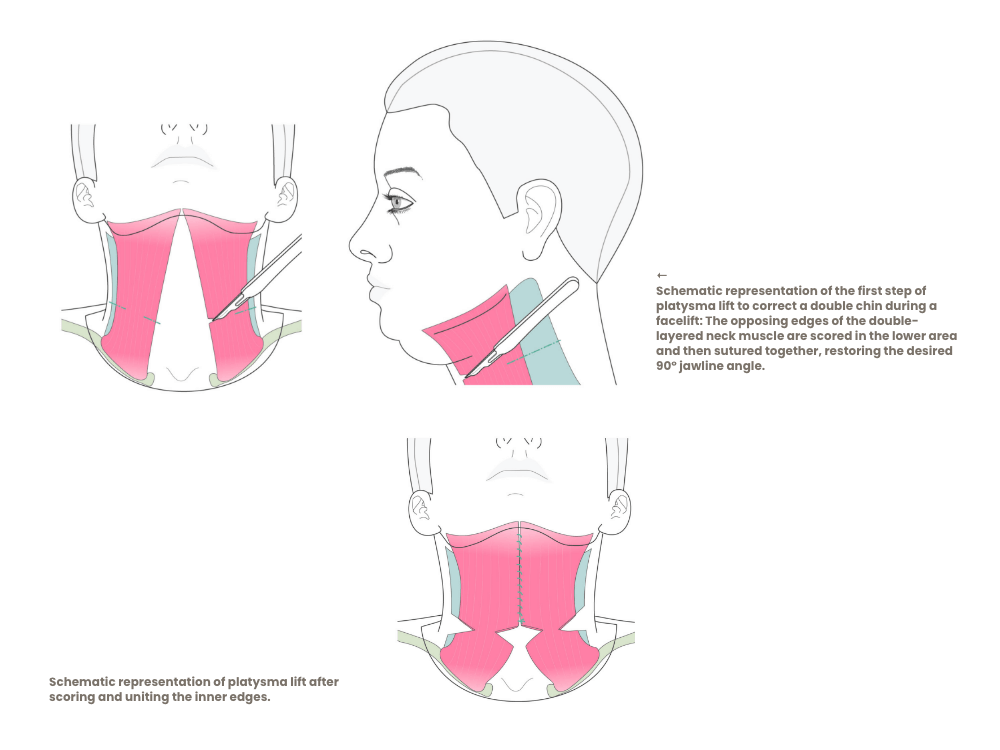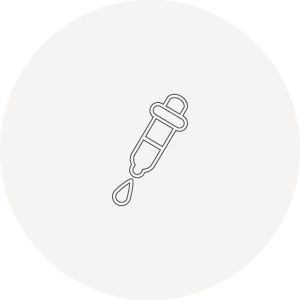With modern techniques: natural appearance and no loss of facial expression
Modern surgical methods allow for targeted correction of problem areas and, in experienced hands, achieve very natural results. The once-feared loss of facial expression and distorted mouth corners are no longer an issue when the procedure is performed correctly. We combine the most advanced techniques to achieve optimal outcomes: SMAS-deep plane, MACS-midface, corset-neck, and since 2019, the innovative hemostasis net technique — this eliminates postoperative bleeding, removes the need for drains, and some patients even go home on the day of surgery.
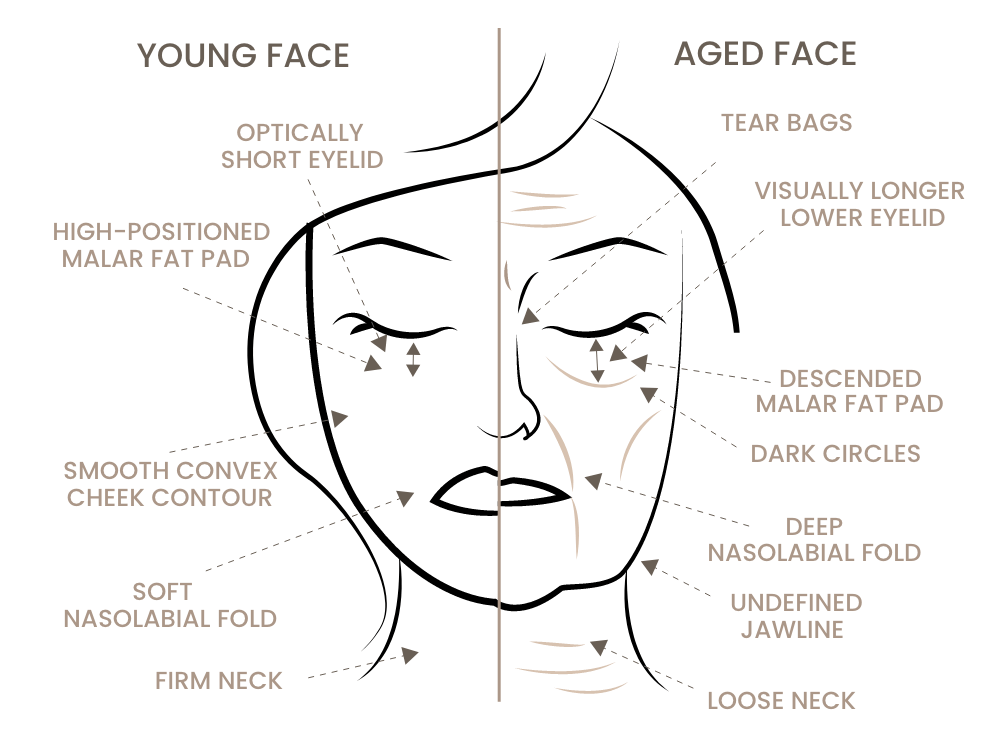
Aging process of the face
Wrinkles, age spots, sagging skin – in some people, these signs are more visible than in others. Factors such as heat and cold, stress and poor nutrition, medications, free radicals, air pollution, alcohol and nicotine consumption, and excessive sun exposure can all accelerate the natural aging of the skin. For minor corrections, autologous fat transfer or PRP (platelet-rich plasma) therapy in the face can be wonderful complementary treatments.
Loss of facial volume
With age, the supporting tissue structures lose firmness, and the face gradually sags under the influence of gravity. In addition, the skin’s elasticity decreases, leading to wrinkles, and over time, the subcutaneous fat layer diminishes — causing further loss of facial volume.
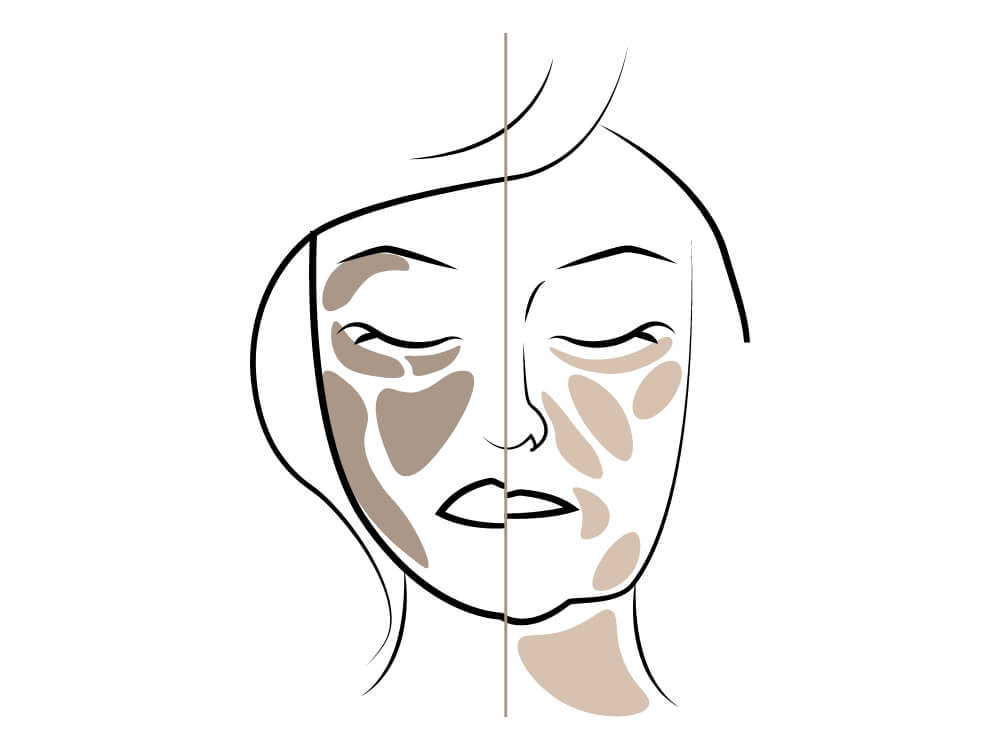
Eliminating wrinkles in the face is less important than restoring the position of sagging structures and lost volume.
Aesthetic facial surgery must address these three aspects:
- Repositioning of sagging structures
- Elimination of skin folds
- Restoration of volume in flattened areas
From a plastic surgery perspective, the face is divided into four regions:
- Forehead
- Midface
- Cheeks
- Neck
Each of the four facial regions can age differently and appear individually aged. We all know how varied the extent of “jowls” can be between two people of the same age — and even within the same face, distinct regional differences in aging can occur. For example, a pronounced double chin may be present while the cheeks remain smooth and firm. This clearly shows how essential a precise problem analysis is when planning a facelift.
All four facial regions must be regarded as separate, independently correctable areas of the face, and for each of them, there are numerous corrective techniques that differ significantly in terms of effectiveness and surgical extent.
Correction of the aging face involves four regions
A detailed analysis of the problem areas is crucial for proper surgical planning and achieving a natural-looking result. The fundamental facelift techniques have changed very little since the discovery of the SMAS (in 1972) and the corset technique (in 1990). We adapt their invasiveness depending on preference, experience, and the patient’s starting anatomy. Great expertise is required to apply the right degree of correction in each of the four facial regions, ensuring the perfect balance between natural appearance and desired rejuvenation.
Forehead
A forehead lift is performed to eliminate forehead wrinkles and lift the eyebrows. It is an effective method to remove a “stern” or “tired” facial expression, as the position of the eyebrows greatly influences one’s overall appearance.
A successful forehead lift can have a similarly rejuvenating effect as a well-performed cheek lift. The height of the forehead is crucial in determining the most suitable forehead lift technique.
Three methods are available:
- Coronal forehead lift
- Pretrichial forehead lift
- Endoscopic forehead lift
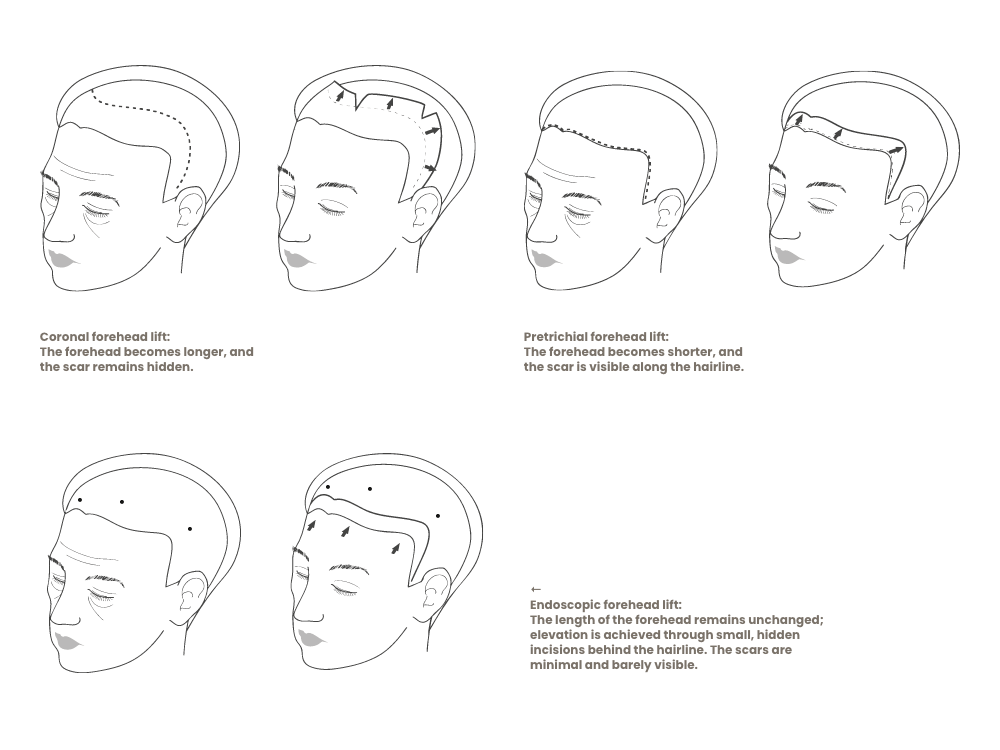
If you are interested in a forehead lift and have a low forehead, the coronal forehead lift is the best option. In this method, the incision runs in a curved line within the hair-bearing scalp. In addition to removing forehead wrinkles and lifting the eyebrows, this procedure also slightly increases forehead height.
If you have a high forehead, the pretrichial forehead lift is more suitable. Here, the incision is placed along the hairline. In addition to removing forehead wrinkles and lifting the eyebrows, this technique lowers the height of the forehead.
In the endoscopic forehead lift, no excess skin is removed, resulting in almost invisible scars. However, it is significantly less effective than the coronal or pretrichial techniques.
Midface
The midface lift is used to correct the region that extends from the lower edge of the bony eye socket to the lateral corner of the mouth. This area often shows signs of aging earlier than other facial regions. Due to volume loss and tissue sagging, the midface descends, leading to the formation of dark circles under the eyes, flattening of the cheekbone area, and more pronounced nasolabial folds.
The midface lift therefore has three main goals:
- Correction of dark circles under the eyes
- Restoration of volume in the flattened inner cheekbone area
- Correction of nasolabial folds
Three methods are available:
- Subperiosteal midface lift
- Midface lift using the MACS technique (Minimal Cranial Suspension)
- Midface lift with extended SMAS flap
Please don’t be intimidated by the medical terminology. The choice of technique depends on the anatomical conditions — that is, which of the three problem areas (dark circles, cheekbone region, nasolabial folds) is most prominent.
If the dark circles are pronounced, the upper tissue layer must be lifted, which is best achieved using the MACS technique. This method also effectively corrects the nasolabial folds, as the SMAS — the tissue layer located directly beneath the skin — is lifted.
If the main concern is a flattened cheekbone area, volume restoration is required in this region, making the subperiosteal technique ideal. However, this method is less effective for correcting nasolabial folds.
The third technique is not an independent procedure but can be used as an extension of a cheek lift. If, in addition to a sagging midface, there are jowls and wrinkles in the cheek area, the midface can also be corrected by extending the SMAS flap technique during a cheek lift. However, it is not as effective as the MACS technique.
Cheek
Cheek lifting is the most frequently performed aesthetic facial surgery and offers the widest range of different techniques.
A cheek lift can correct jowls and restore volume to a laterally flattened cheekbone area, but it has limited effect on the nasolabial folds and does not correct dark circles or eye bags.
The classic among the available methods is the cheek lift with the SMAS flap. At the same time, it is also the most effective technique for sustainably correcting jowls and wrinkles. It is a two-layered procedure in which the SMAS is tightened, the cheek skin is gently redraped, and the excess skin is removed before being reattached without tension. This approach prevents the dreaded loss of facial expression.
Important note: SMAS tightening is not always the same! The SMAS can either simply be folded (plicated) or actually separated from the underlying tissue in the cheek and zygomatic area and dissected downward and inward toward the nasolabial fold. Only this latter method can achieve the full effectiveness of the technique — however, it requires significantly more time and precise care to protect the fine branches of the facial nerve (n. facialis). The deep-plane facelift is currently the most advanced and demanding technique. It requires patience and extensive experience; it is the most effective method, but it also causes longer-lasting swelling.
In addition to this method, there is a wide range of less invasive techniques that require less effort but are also significantly less effective. These include so-called “modern” methods often advertised in magazines, which claim faster healing and shorter recovery times. However, such procedures are only suitable for relatively young patients, where only minor corrections are needed. Offering a mini-lift to a 60-year-old patient with typical age-related issues is neither appropriate nor responsible.
A cheek lift can be easily extended to include a limited neck lift with minimal additional effort.
Neck
Neck tightening is most often performed in combination with a cheek lift but can also be carried out as a standalone procedure.
There are three available methods:
- Neck tightening through skin removal only
- Neck tightening using the SMAS technique
- Neck tightening using the corset technique according to Feldmann
Neck lifting by simply removing excess skin behind the ear is outdated and only minimally effective. The standard method is the lateral tightening of the platysma using the SMAS technique. The platysma is the superficial paired neck muscle that transitions laterally into the SMAS. Its laxity leads to the formation of a double chin.
The by far most effective method is the corset procedure according to Feldmann, as it unites both halves of the platysma, creating a new, band-like anatomical structure that allows the neck to be repositioned inward and upward. As a result, the neck once again forms a right angle in profile view. Please take a look at the photos — the results achieved with the Feldmann technique are often truly remarkable.
